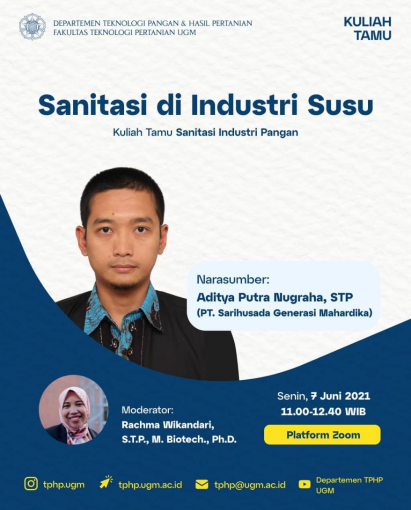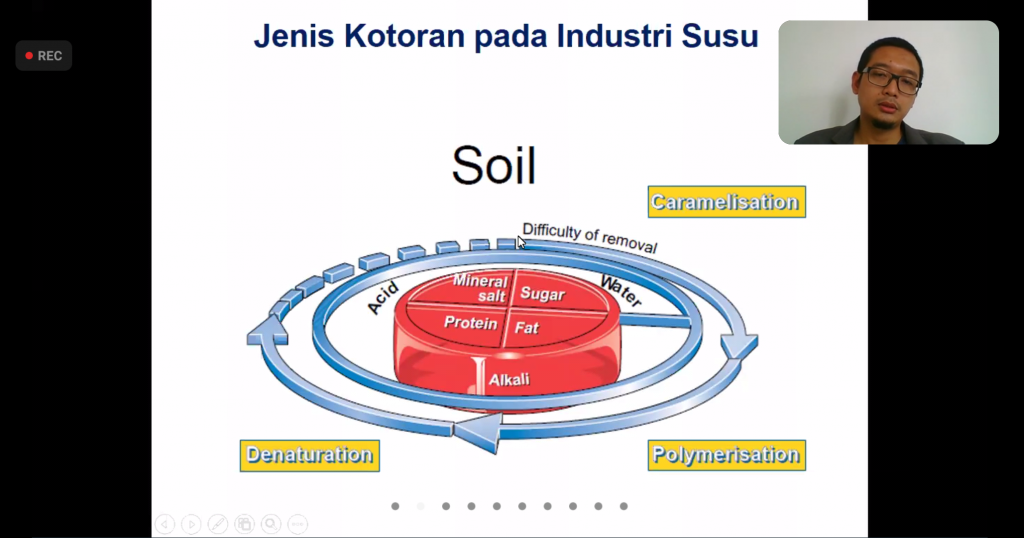
On Monday, June 7, 2021, the TPHP UGM Food Industry Sanitation course held a guest lecture with the theme “Sanitation in the Dairy Industry”. This guest lecture was presented by Aditya Putra Nugraha, S.T.P. from PT Sarihusada General Mahardika and hosted by Rachma Wikandari, S.T.P., M.Biotech, Ph.D., a lecturer at TPHP UGM. The guest lecture which took place at 11:00-12:40 WIB was held through the Zoom platform and was attended by 115 participants.
Cleaning is the process of freeing a surface from all dirt or other substances with no impact or damage to the surface being cleaned. The purpose of the cleaning process is to clean the surface of the tool or machine from dirt and contamination because this will directly affect the quality of food.
The parts that need to be cleaned include surfaces in contact with the product, surfaces in contact with hands or limbs, as well as shelter and growth of bacteria. Product-contact surfaces, such as piping through which milk flows, process machinery, knives, and material tables. Surfaces in contact with hands or limbs, such as door handles, manholes, glassware, refrigerant, floors, walls, glass, and others. Places of refuge and growth of bacteria, such as workers’ clothing, cleaning tools (brooms, brushes, rags, mops, etc.), avfal (reject products), trash bins, and water traps.
The materials used for cleaning are detergent, disinfectant (hot water, steam, chemical), and sanitizer. Detergent serves to remove dirt, dust, and oil. Disinfectants reduce the growth of bacteria to a safe level. Sanitizers are chemicals that reduce the number of growing microorganisms and their spores to safe levels for humans.

The types of impurities in the dairy industry include sugar, fat, protein, and mineral salts. Sugar has water-soluble properties and is easy to clean, but if exposed to heating poses will experience caramelization so it becomes difficult to clean. Fat is soluble in alkali, but insoluble in water and difficult to clean, and if exposed to the heating process will undergo polymerization, making it even more difficult to clean. Proteins are alkali-soluble, slightly acid soluble, but water insoluble and very difficult to clean, and if exposed to the heating process will denature making it much more difficult to clean. Mineral salts are soluble, some types are acid soluble, cleaning is easy to difficult, and the heating process has little effect on the surface cleaning process.
The stages of cleaning and disinfecting in the CIP (Cleaning In Place) process are initial rinsing, circulation with alkali, rinsing with water, circulation with acid, and final rinsing. Initial rinsing serves to remove dirt so that the cleaning power of the detergent is not weakened and minimizes the amount of chemicals to be used. Circulation with alkali serves to remove protein and fat. The second rinse serves to remove residual alkali. Circulation with acid serves to remove dirt deposits. The final rinse serves to remove residual acid.
The alkaline material used as a cleaning agent is NaOH (sodium hydroxide) which serves to kill bacteria and remove proteins, fats, and sugars. NaOH is used at a concentration of 1 – 1.5%, pH 13 – 13.5, and a minimum temperature of 80°C. Meanwhile, the acids used as cleaning agents are HNO3 (nitric acid) and H3PO4 (phosphoric acid) which function to destroy spores and remove residues of minerals, fats, sugars, and proteins. HNO3 and H3PO4 are used at a concentration of 0.6 – 1.2%, a pH of 1.5, and a temperature of around 60 – 80°C.
The Food Industry Sanitation Guest Lecture video can be accessed through the following link
